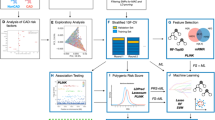Abstract
Purpose of review
To review the opportunities and challenges of phenotyping cardiovascular diseases in the modern era.
Recent findings
More recently, the emerging field of precision medicine aims to provide the best available care for each patient based on stratification into new disease subclasses with a common biological basis. The discovery of such subclasses at the correct scale and speed, as well as the translation of this knowledge into clinical care, will depend critically upon digital and computational resources to capture, store, and exchange phenotypic data and upon sophisticated algorithms to integrate these data with genomic variation, functional genomics profiles, and existing clinical information. Deep phenotyping can be defined as the comprehensive and precise analysis of phenotypic traits/abnormalities for such stratification. Recently, the term phenotype has largely been used to understand the “binary” output of a specific genetic code, in so-called genotype-phenotype correlations, but this has tended to constrain the use of the terminology to artificially dichotomized disease syndromes.
Summary
In the modern world, as we incorporate functional genomics into disease analysis, there has been a call to transform our understanding of individual patients via deep phenotyping or a more comprehensive study of the phenotype, i.e., multidimensional phenomics. Cardiovascular medicine, with its heterogeneity, prevalence, and therapeutic options, is a prime focus of precision medicine. In this article, we outline the current state of deep phenotyping in cardiovascular disease, including the rationale, current challenges, and opportunities for the future.
Similar content being viewed by others
References and Recommended Reading
Papers of particular interest, published recently, have been highlighted as: • Of importance •• Of major importance
Thomas H, et al. Global Atlas of Cardiovascular Disease 2000–2016: The Path to Prevention and Control. Glob Heart. 2018;13(3):143–63.
Angell SY, et al. The American Heart Association 2030 Impact Goal: A Presidential Advisory From the American Heart Association. Circulation. 2020;141(9):e120–38.
Robinson PN. Deep phenotyping for precision medicine. Hum Mutat. 2012;33(5):777–80.
Shah SH, et al. Opportunities for the cardiovascular community in the precision medicine initiative. Circulation. 2016;133(2):226–31.
• Chong JX, et al. The genetic basis of Mendelian phenotypes: discoveries, challenges, and opportunities. Am J Hum Genet. 2015;97(2):199–215 A Summary of modern phenotypes.
Nachtomy O, Shavit A, Yakhini Z. Gene expression and the concept of the phenotype. Stud Hist Philos Biol Biomed Sci. 2007;38(1):238–54.
Benjamin I, et al. American Heart Association Cardiovascular Genome-Phenome Study: foundational basis and program. Circulation. 2015;131(1):100–12.
Li W, et al. SCN5A Variants: Association With Cardiac Disorders. Front Physiol. 2018;9:1372.
Pereira R, et al. Phenotypic variability and incomplete penetrance of spontaneous fractures in an inbred strain of transgenic mice expressing a mutated collagen gene (COL1A1). J Clin Invest. 1994;93(4):1765–9.
O’Donnell CJ. Opportunities and challenges for polygenic risk scores in prognostication and prevention of cardiovascular disease. JAMA Cardiol. 2020.
Ndiaye NC, et al. Cardiovascular diseases and genome-wide association studies. Clin Chim Acta. 2011;412(19–20):1697–701.
Houle D, Govindaraju DR, Omholt S. Phenomics: the next challenge. Nat Rev Genet. 2010;11(12):855–66.
Schmitter D, Cotter G, Voors AA. Clinical use of novel biomarkers in heart failure: towards personalized medicine. Heart Fail Rev. 2014;19(3):369–81.
Yancy CW, Lee DC. Personalized medicine in heart failure: are we there yet? JACC Cardiovasc Imaging. 2012;5(4):419–21.
Schirmer SH, Hohl M, Bohm M. Gender differences in heart failure: paving the way towards personalized medicine? Eur Heart J. 2010;31(10):1165–7.
Bilder RM, et al. Phenomics: the systematic study of phenotypes on a genome-wide scale. Neuroscience. 2009;164(1):30–42.
Bravata DM, et al. Using pedometers to increase physical activity and improve health: a systematic review. JAMA. 2007;298(19):2296–304.
Perez MV, et al. Large-scale assessment of a smartwatch to identify atrial fibrillation. N Engl J Med. 2019;381(20):1909–17.
Delude CM. Deep phenotyping: the details of disease. Nature. 2015;527(7576):S14–5.
LeCun Y, Bengio Y, Hinton G. Deep learning. Nature. 2015;521(7553):436–44.
Diogo D, et al. Phenome-wide association studies across large population cohorts support drug target validation. Nat Commun. 2018;9(1):4285.
Denny JC, et al. PheWAS: demonstrating the feasibility of a phenome-wide scan to discover gene-disease associations. Bioinformatics. 2010;26(9):1205–10.
John B, Lewis KR. Chromosome variability and geographic distribution in insects. Science. 1966;152(3723):711–21.
Kulminski AM, et al. Uncoupling associations of risk alleles with endophenotypes and phenotypes: insights from the ApoB locus and heart-related traits. Aging Cell. 2017;16(1):61–72.
•• Leopold JA, Loscalzo J. Emerging role of precision medicine in cardiovascular disease. Circ Res. 2018;122(9):1302–15 A Review of the challenges facing precision medicine.
Author information
Authors and Affiliations
Corresponding author
Ethics declarations
Conflict of Interest
Sunil Kapur and Calum A MacRae declare that they have no conflict of interest.
Human and Animal Rights and Informed Consent
This article does not contain any studies with human or animal subjects performed by any of the authors.
Additional information
Publisher’s Note
Springer Nature remains neutral with regard to jurisdictional claims in published maps and institutional affiliations.
This article is part of the Topical Collection on State-of-the-Art Informatics
Rights and permissions
About this article
Cite this article
Kapur, S., MacRae, C.A. Deep Phenotyping in Cardiovascular Disease. Curr Treat Options Cardio Med 23, 1 (2021). https://doi.org/10.1007/s11936-020-00881-3
Accepted:
Published:
DOI: https://doi.org/10.1007/s11936-020-00881-3




